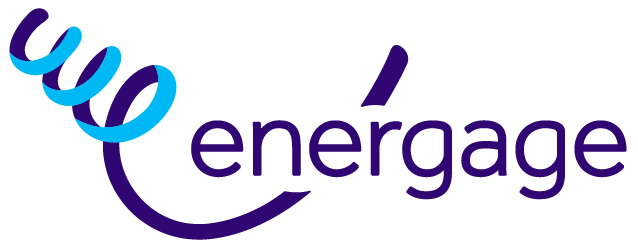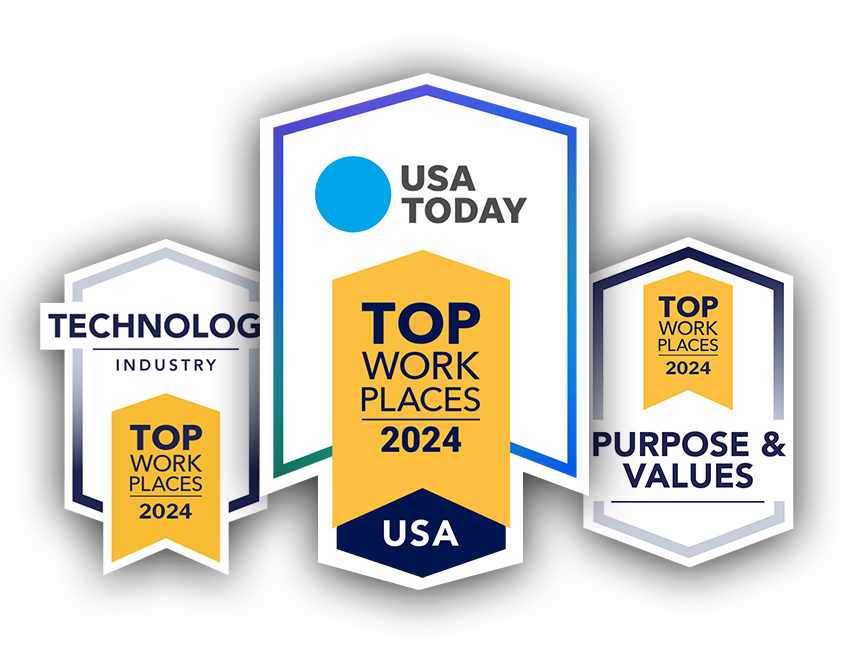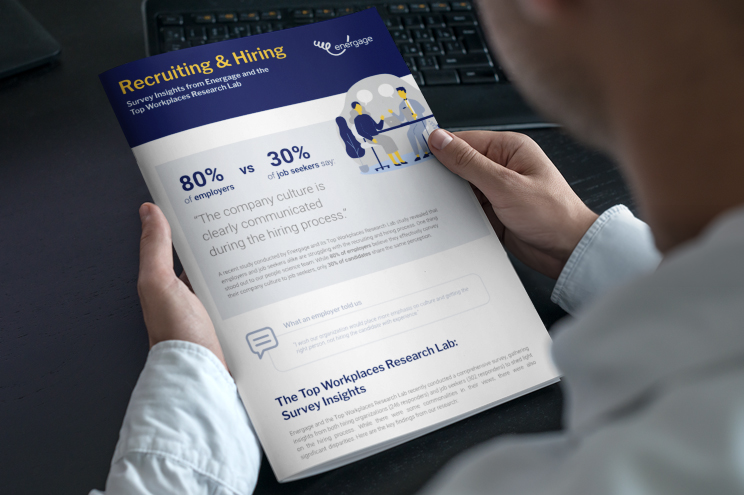Remote and Hybrid Work Trends in 2024
Insights from the Energage People Science Team
By Dr. Greg Barnett
One of the questions our People Science Team gets a lot is about what’s going on with remote/hybrid work and whether we are seeing any trends worth knowing. That’s because a little more than 3.5 years ago, the world of work changed forever. Many companies were thrust into an unknown world of communicating, collaborating, and executing in a remote world.
But as the Pandemic waned, so did the need to remain remote. Some companies quickly returned to working on-site, while others stuck with fully remote or attempted a mixed hybrid work model.
As time has passed, companies have grappled with finding the right work mix for their needs. Some companies – such as Disney, Amazon, BlackRock, and JPMorgan – made big waves as they mandated full returns to the office. Others attempted to find the best balance of on-site vs. remote work, experimenting with different hybrid work policies.
With 2023 behind us, now is a good time to evaluate current models to understand what’s happening across the broader workplace landscape. Examining Energage Workplace Survey data from more than 2 million employees at over 6,000 organizations in the last two years, our team uncovered some clear and undeniable facts and trends.
An emerging gap: less remote, more on-site
Companies continue to move away from remote-oriented work. Our data shows that at the beginning of 2022, there was an 18% gap between employees working mostly remote and employees working mostly on-site. While the gap seems sizable, it’s important to remember that several industries, such as hospitality and retail, can’t offer remote work options outside corporate support roles. But as we progress from Q1 of 2022 to Q4 of 2023, the gap widens significantly, with a 34-point gap emerging between mostly or fully remote employees versus those who are mostly or fully on-site.
Fully/Mostly On-Site vs Fully/Mostly Remote:
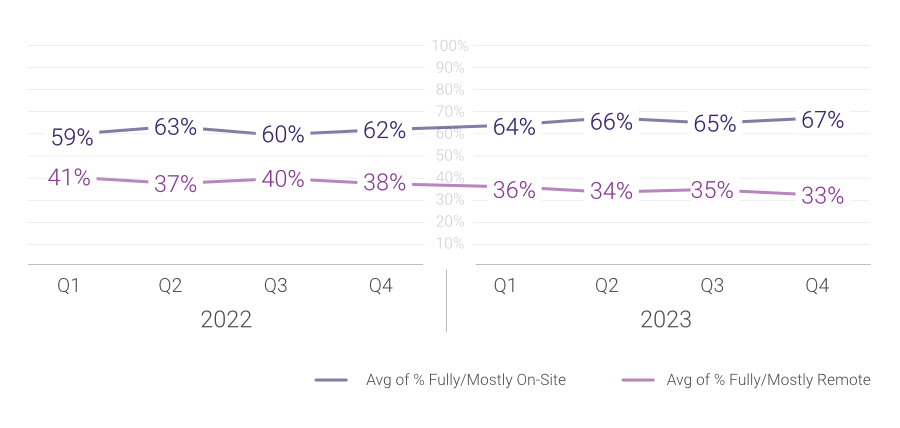
Hybrid work remains stable
Taking a deeper dive, the gap between fully on-site and fully remote work grew from 19% in Q1 of 2022 to 29% by the end of 2023. It also appears that the percentage of organizations working remotely hit a potential floor at ~18%. That is a number worth tracking throughout 2024.
In addition, the number of employees in a hybrid work situation remains stable. This suggests that the fully on-site to fully remote gap has increased because more companies are switching from fully remote to fully on-site rather than a hybrid arrangement.
Fully On-Site vs Hybrid vs Fully Remote:
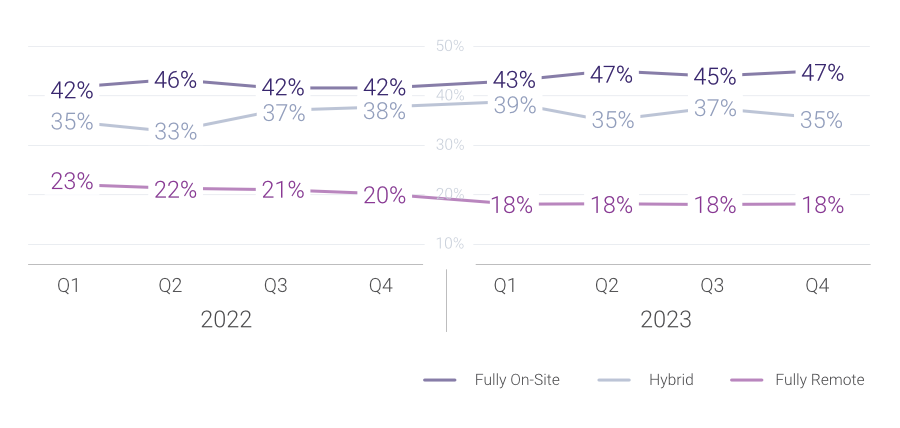
Hybrid work is trending towards on-site
A further analysis of hybrid work is broken down into employees who report being mostly remote (e.g., three or more days remote) vs. mostly on-site (e.g., three or more days in the office), suggests that while the distribution was generally even throughout most of 2022, we are slowly seeing companies move their employees into a hybrid arrangement that involves more days on-site than remote.
In addition, the number of employees in a hybrid work situation remains stable. This suggests that the fully on-site to fully remote gap has increased because more companies are switching from fully remote to fully on-site rather than a hybrid arrangement.
Hybrid: Mostly On-Site vs Mostly Remote:
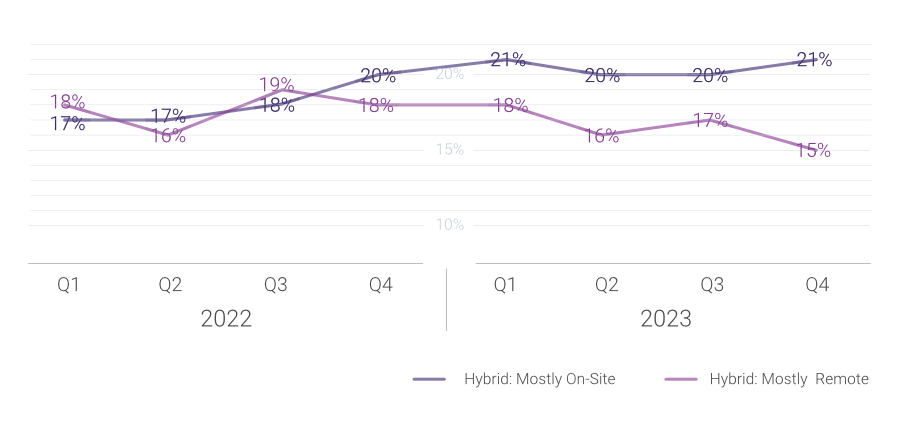
Industry differences matter
Global trends paint an intriguing picture, suggesting that remote work is gradually losing its popularity, which is a trend many expect. The industry data captured by the survey question about work location provides a better understanding of where on-site, hybrid, and remote structures are most popular. The short answer? There are no industries where fully remote work is the predominant work arrangement. Instead, we see almost an even split where nine industries are predominantly fully on-site, whereas eight are predominantly hybrid. The distribution isn’t even close in some industries, such as Education. Yet in others, such as Life Science, there are nearly equal employees in fully on-site and hybrid work situations.
Percentage of Employees in Each Work Location:
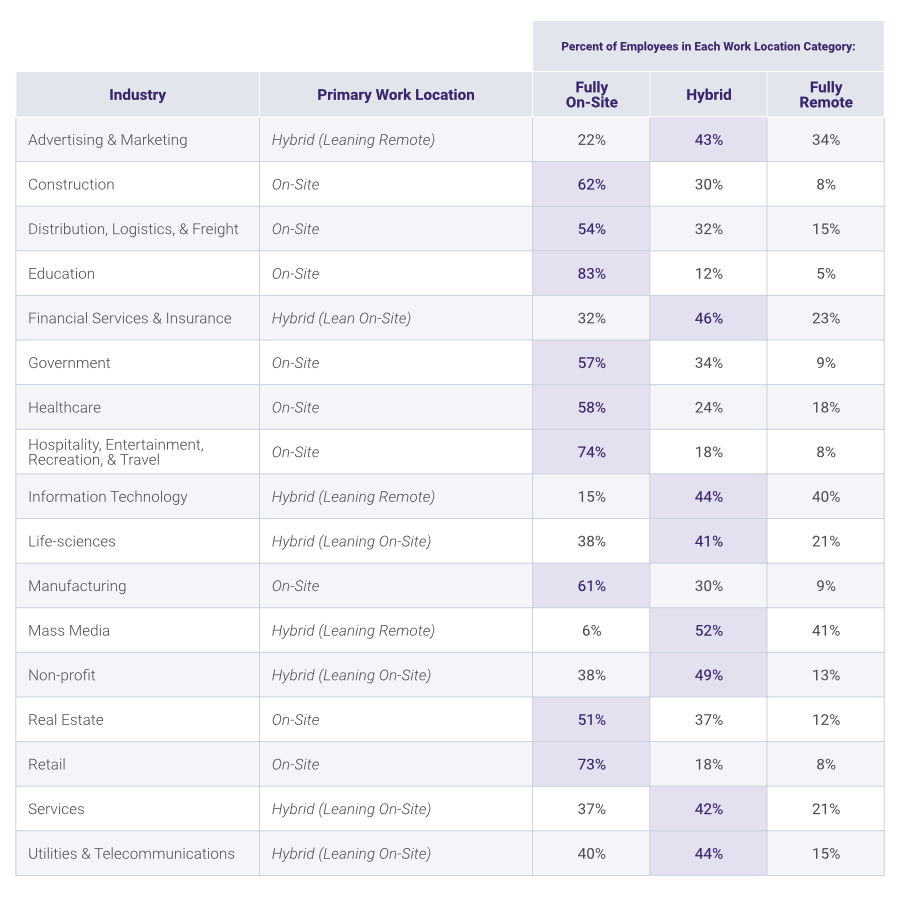
Work flexibility helps employee engagement
Looking at organizations that took the Energage Workplace Survey in 2023, the results show that fully remote and hybrid employees are significantly more engaged than fully on-site employees. This data partially reflects the nature of industries that don’t permit hybrid work, like Education, where historically, employee engagement tends to be lower. However, when individuals have the flexibility to work remotely, their engagement tends to increase.
Employee Engagement Differences:
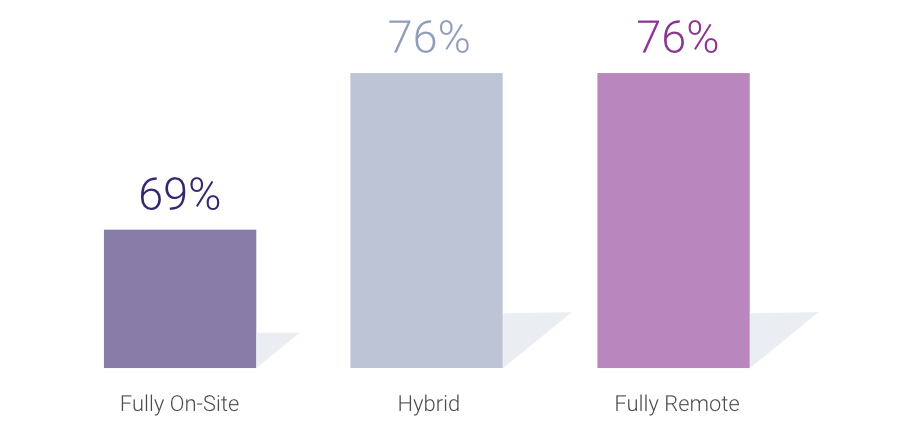
No clear winner at an industry level
The preceding data suggested that some level of remote work leads to better employee engagement. This chart, with data from 2023, highlights differences in employee engagement based on work situations for each industry. In some cases, there are small to no differences between hybrid and fully remote employees, such as in Information Technology and Life Sciences.
In other industries, such as Education, there are larger differences indicating that being fully remote is meaningfully more engaging than any situation that involves on-site work.
In the Construction sector, there are minimal differences between fully on-site, hybrid, or remote setups. This is likely due to the nature of the work. In a way, it is almost as if on-site employees are working remotely.
Ultimately, this information aims to guide companies in recognizing the industry-specific trends that may deviate from the broader global trends often discussed.
Employee Engagement at Industry Level:
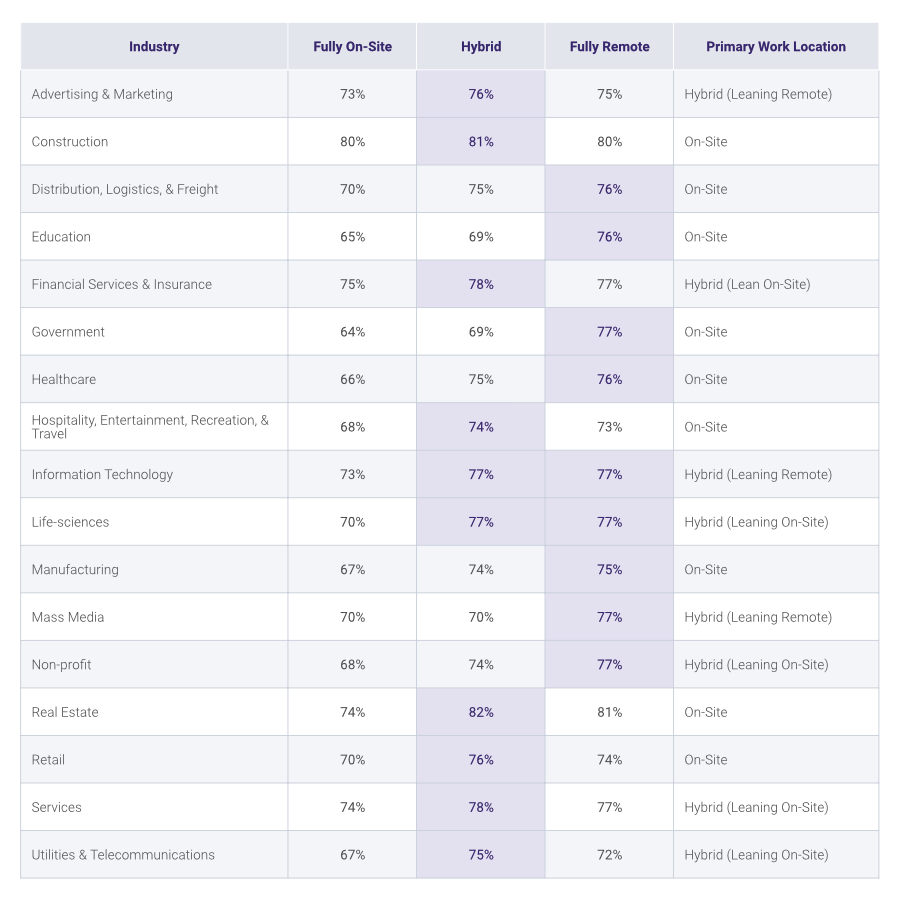
Remote and hybrid win across all workplace experience areas
When looking at the 23 core statements of the Energage Workplace Survey, we found no areas where fully on-site work environments are rated more highly than hybrid or fully remote.
What we did find, however, are certain areas where the experience gap is bigger. Fully remote employee ratings are 14% more positive on Work-Life Flexibility and 10% higher on Meeting quality, perceived Open-Mindedness, and feeling Clued-In about the information needed to do the job.
In contrast, aspects of effective Execution, feelings that work has Meaning, and Formal Training are closer to fully on-site ratings. Even though the ratings are still higher for fully remote and hybrid workers, these will tend to be areas where leaders will express concern. Namely, remote employees are less connected to the broader company mission (e.g., the meaningfulness), not learning and growing as they should be, and their physical distance from others hurts execution efficiency.
Workplace Experience Areas:
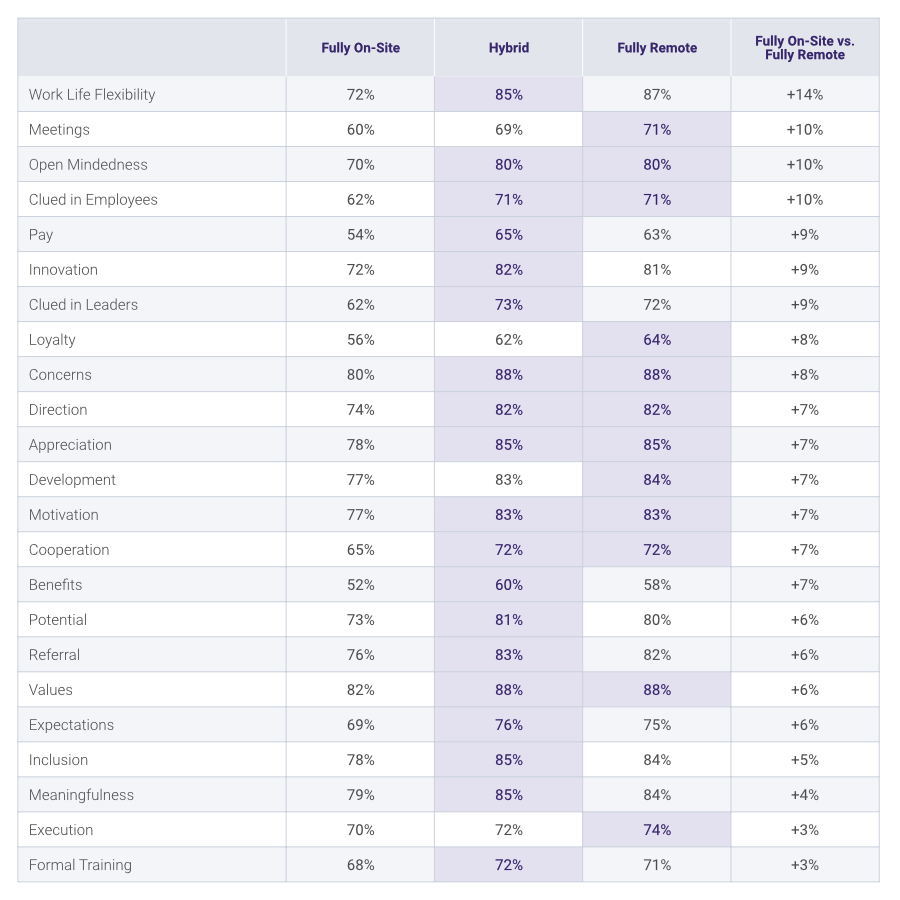
Benchmark your workplace today
Now that you’ve explored the changing landscape of remote and hybrid work in 2024, take the next step! Measure your organization against industry trends with the Energage Workplace Survey. See how your workplace structure compares, uncover your workplace culture strengths, and get data-driven actionable insights for improvement.
